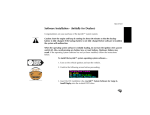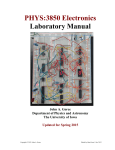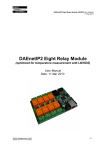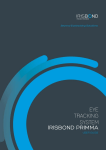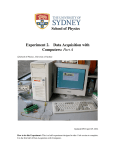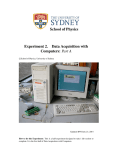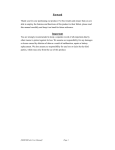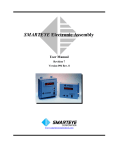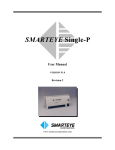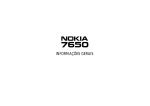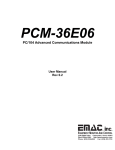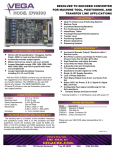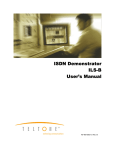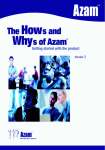Download Oxygen Meter User Manual
Transcript
Oxygen Meter User Manual Monday, July 23, 2007 1. Outline .......................................................................................................................... 2 2. Program ........................................................................................................................ 3 3. 2.1. Environment for program execution .................................................................... 3 2.2. Installation ............................................................................................................ 3 2.3. Un installation ...................................................................................................... 3 2.4. USB driver installation ........................................................................................ 3 2.5. Text-to-Speech Engine .......................................................................................... 3 Operation...................................................................................................................... 4 3.1. Preparation ........................................................................................................... 4 3.2. Execution............................................................................................................... 4 3.3. Main window ......................................................................................................... 5 3.4. Zero_Point calibration .......................................................................................... 7 3.5. Gas calibration ...................................................................................................... 8 3.6. Liq Calibration ...................................................................................................... 9 3.6.1. Liq calibration at the temperature measurement enabled.......................... 9 3.6.2. Liq calibration at the temperature measurement disabled ....................... 10 3.7. Gas Start ............................................................................................................. 11 3.8. Liq Start .............................................................................................................. 13 3.9. Data transfer to Excel etc ................................................................................... 14 3.10. Changing language.......................................................................................... 14 4. Restrictions................................................................................................................. 15 5. Notes for Operation.................................................................................................... 15 References.......................................................................................................................... 16 Appendix-1 DC Voltage Measurement Circuit................................................................. 17 (1/19) 1. Outline This is an educational oxygen meter to understand oxygen concentration in gas or liquid. This measures oxygen concentration and temperature, and then displays them in a graph. Following shows the measurement system. The oxygen sensor is a Galvanic battery type sensor. This sensor generates a DC voltage proportional to the oxygen concentration. The temperature sensor is LM35DZ transistor type sensor from the National Semiconductor. This generates a DC voltage proportional to the temperature. The DC voltage measurement circuit amplifies the DC voltages from the both sensors, converts to digital values, and sends them to a Personal computer via USB cable, The personal computer displays measured values and also speaks the values by a speaker.. Features of the Oxygen sensor (1) Low cost. Easy reproducible. (2) Students can easily construct this sensor by themselves (3) Electrode liquid used for sensor is safe for human. (4) Measure both gas oxygen concentration and dissolved oxygen concentration Features of the Temperature sensor (1) It is waterproofed to measure liquid temperature. (2) It is high precise by using semiconductor PN junction voltage. (2/19) Features of this measurement system (1) The DC voltage measurement circuit does not require a DC Power supply, since the DC power is supplied from the USB cable.. (2) Calibration is easy and automatic.. (3) Measured data is displayed in real time. (4) Has an Excel interface (6) Supports bi-language.. (7) Measured values can be spoken from a PC speaker. 2. Program 2.1. Environment for program execution Windows XP, WindowsVista Runtime version of Visual Basic 6.0 Microsoft Text-to-Speech Engine Speaker 2.2. Installation Following are files for installation. z setup.exe z setup.LST z XxxTmpMeterCAB Double click the setup.exe, and follow the procedure guided by the installation program. 2.3. Un installation Uninstall the installed program from the Windows control panel. 2.4. USB driver installation The DC voltage measurement circuit requires a special USB driver. When the USB cable is attached to the PC, the PC requires the USB driver installation. The USB driver is saved in a supplied CD-ROM. Insert the CD-ROM and install the USB driver by setting the searching path to the CD-ROM. When the USB driver is not installed completely, the following message will be displayed. "Can not find USB-COM Port !" 2.5. Text-to-Speech Engine Install the Text-Speech Engine. Those engine files can be downloaded from the next url page. (3/19) Microsoft Agent download page for end-users http://www.microsoft.com/msagent/downloads/user.asp (1)SAPI 4.0 runtime support: Download the Microsoft SAPI 4.0a runtime binaries (824 KB exe) File name: Spchapi.exe (2)Text-to-speech engines: Download selected engine Lernout & Hauspie@TTS 3000 TTS engine – Japanese(3MB exe) File name: lhttpsjpj.exe Downloaded files are already saved in the CD-ROM. You can install engines from those files. 3. Operation 3.1. Preparation Connect the DC Voltage measurement circuit to the PC using the USB cable. 3.2. Execution Double click the program file, XxxTmpMeter.exe, or its short cut icon. Main windows will be opened. (4/19) 3.3. Main window Main window when the temperature measurement is enabled. (5/19) Main window when the temperature measurement is disabled. Zero_Point calibration: Calibrates offset voltage of the DC Voltage measurement circuit for oxygen concentration measurement. Gas Calibration: Calibrates the oxygen concentration in gas. Liquid calibration: Calibrates the dissolved oxygen concentration in liquid. Setting: Enable or disable the temperature measurement function. Help: Displays version and how to use this software. Japanese: Changes language to Japanese; English: Changes language to English COM Port: Displays assigned com port. The DC Voltage measurement circuit has USB-Serial conversion circuit in which the USB driver automatically assigns a COM port for the USB channel. Excel Out: When checked, the software displays measured data in Excel after measurement completion. Voice Out: When checked, the measured value is spoken by PC speaker Sampling interval and count: sampling interval and count selections from this combo (6/19) boxes. Sensor out (mV): Sensor output voltage from the DC Voltage measurement circuit. Oxygen(%): Oxygen concentration. This is converted value from the above sensor out voltage. Temp(°C): Temperature. This is converted value from the temperature sensor our voltage. Lower text boxes: Displays sampling interval, sampled count, measured oxygen concentration and temperature. Graphic window: Displays graphically the measured oxygen concentration and temperature. Gas start: Starts oxygen concentration measurement in gas. Liq start: Starts dissolved oxygen concentration measurement in liquid. Stop: Stops measurement. Exit: Exits from this program. Copy: Copies the measured data to a Window clip board. Excel: Displays the measured data in Excel. File: Files the measured data into a file. 3.4. Zero_Point calibration This calibrates offset voltage from Oxygen sensor. When the Zero_Point calibration menu is clicked, the following window will be opened. Short input terminals from oxygen sensor, and click the start button. Sensor output voltage is measured 10 times and average value is saves as an offset calibration voltage. (7/19) Hereafter sensor output voltage will be compensated by this value. This calibration is required only one time after when DC voltage measurement circuit is connected to the PC. 3.5. Gas calibration Sensor out voltage from pure atmosphere of gas concentration 20.9% is used for gas oxygen concentration calibration. When the Gas calibration menu is clicked, the following window will be opened. Set oxygen sensor in pure atmosphere, click the start button. Sensor output voltage is measured 10 times and average value is automatically saves as a gas calibration voltage. (8/19) 3.6. Liq Calibration Saturated dissolved oxygen concentration in pure water depends on water temperature. The relation between the saturated dissolved oxygen concentration and the temperature is measured and booked. The temperature and the sensor out voltage from oxygen saturated dissolved pure water are used for dissolved oxygen concentration calibration. 3.6.1. Liq calibration at the temperature measurement enabled Both the temperature and the oxygen concentration are measured at the same time. When the Liq calibration menu is clicked, the following window will be opened. (9/19) Set oxygen sensor and temperature sensor in pure water, click the start button. Oxygen sensor output voltage and temperature are measured 10 times and average values are calculated. The temperature and the saturated oxygen sensor out voltage for the temperature are automatically saved as dissolved oxygen calibration values. 3.6.2. Liq calibration at the temperature measurement disabled The temperature is measured by another sensor. When the Liq calibration menu is clicked, the following window will be opened. Key in the temperature value and set oxygen sensor in pure water, click the start button. Oxygen sensor output voltage is measured 10 times and average values are calculated. The temperature and the saturated oxygen sensor out voltage for the (10/19) temperature are automatically saved as dissolved oxygen calibration values. 3.7. Gas Start This starts gas oxygen concentration measurement. Select sampling interval and count, and click the Gas start button. Lower text boxes display measured gas oxygen concentration and temperature. Lower picture window displays the measured data graphically. When Excel out flag is checked, the measured data is displayed by Excel after measurement completion. (11/19) (12/19) 3.8. Liq Start This starts dissolved oxygen concentration measurement. Select sampling interval and count, and click the Liq start button When the measurement is for dissolved oxygen, the back ground colors of data are blue. Lower text boxes display measured dissolved oxygen concentration and temperature. Lower picture window displays the measured data graphically. When Excel out flag is checked, the measured data is displayed by Excel after measurement completion. (13/19) 3.9. Data transfer to Excel etc Lower text boxes display measured oxygen concentration and temperature. Excel button displays the measured data in Excel. Copy button copies the measured data into Window clip board. The clip board data can be pasted in Excel. File button files the measured data in a file. 3.10. Changing language Clicking Japanese menu changes language to Japanese. Clicking English menu changes language to English. (14/19) 4. Restrictions (1) One PC can use only this one oxygen meter. (2) When Excel is used, Excel license from Microsoft is required. (3) Temperature sensor is LM35DZ from the National Semiconductor. This works from 0°C to 50°C. (4) In this version, the Text-to-Speech engine can not work for English language. 5. Notes for Operation (1) Temperature sensor is water resistant. Use the temperature sensor at the temperature range from -10 °C to 60°C.. Usage outside this range will damage the sensor. (2) When you insert or remove the USB cable, handle the USB cable at fixing the USB connector. (3) To work with Text-to-Speech function, the software must be installed completely and a speaker must be attached to the PC. (4) To follow the Text-to-Speech function, the sampling time must be greater than 3 seconds.. (15/19) . References [1] Mitsuo Takahashi “ Trail and Experiment of Oxygen sensor”, Transistor Gijytsu ( Japanese), 12, 2003 (16/19) Appendix-1 DC Voltage Measurement Circuit (17/19) Hereafter shows adjustments and cable connections. Most adjustments have been executed before shipment. Usually adjustments are not needed for users. z Terminal Block TB1 This has three terminals. This connects temperature sensor. TB1-1: VCC (Red wire) TB1-2: Temperature sensor out (White wire) TB1-3:: GND (Black wire) z Terminal Block TB2 This has two terminals. This connects oxygen sensor. TB2-1: Oxygen sensor out (Red wire) TB2-2: GND (Black wire) z Jumper J1 This selects temperature sensors. Jumper between J1-1 and J1-2: Internal temperature sensor. (Note: Now internal temperature sensor is not implemented.) Jumper between J1-2 and J1-3: External temperature sensor. z Jumper J2 This selects mode of oxygen sensor out. Jumper between J1-1 and J1-2: Oxygen sensor out is current. Jumper between J1-2 and J1-3: Oxygen sensor out is voltage.. z Jumper J3 & J4 This selects sensor types Jumper J3: Oxygen sensor Jumper J4: Other sensor. z Variable resister VR1 This adjusts amplifier gain of temperature sensor out voltage so that the gain is 10.00. This gain is already adjusted at shipment. <How to adjust VR1> Connect the temperature sensor, measure the voltage [V] between JB1-2 and JB1-3, and adjust VR1 such that the temperature display is 100 times the measured voltage. (18/19) e.g. .When the voltage [V] between JB1-2 and JB1-3 is 0.25 [V]. adjust VR1 such that the temperature is 25°C. z Variable resister VR2 This adjusts amplifier gain of sensor out voltage. For the oxygen sensor, this gain is already adjusted at shipment. (19/19)



















